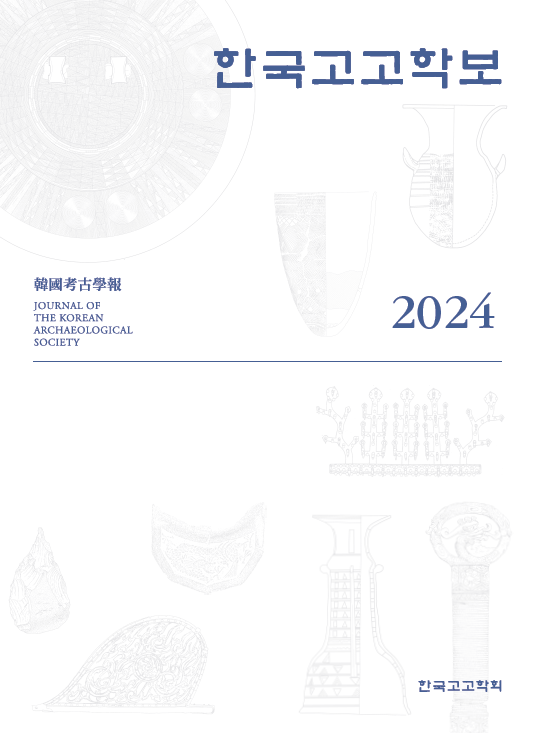모방 유사도를 통해 살펴본 한·일 방제경의 성격 — 원삼국(야요이 후기~고훈 개시기)시대 자료를 중심으로
The Character of Korean and Japanese Imitation Bronze Mirrors Seen through Similarities of Imitation — Focusing on the materials from the Proto-Three Kingdoms period (late Yayoi to the beginning of the Kofun period)
- 64

이 논문은 원삼국[야요이(弥生)~고훈(古墳) 개시기]시대 한반도 남부와 일본열도에서 출현하는 방제경에 대해 원경 대비 모방 유사도를 구분하여, 거울의 유형 분류와 그에 따른 성격 차이를 규명하는 데 목적을 둔다. 방제경은 한국과 일본에서 시기별 모방 대상이나 재질에 따라 그 종류가 다양하다. 하지만 ‘방제경’이라는 명칭은 모방 제작된 거울의 다양성을 온전히 내재하지 않으며, 대체용어로서 제시된 사례 또한 박재품의 반대라는 개념에 초점을 두어 특정 제작지를 상정하는 상황이다. 이러한 양상에 대해, 모방을 통해 창출된 거울을 이해하기 위해서는 향유 주체의 의도가 반영된 모방 유사도와 거울의 성격에 대한 선행적인 검토가 필요하다. 본고에서는 방제경이 유행한 시기 한국과 일본에서 확인된 모방 사례들을 대상으로 행위의 제작 경향을 살펴보아 상사성과 상이성을 도출하고 3개의 모방 유형을 설정하였다. 도출된 유형은 유물의 존재 시기를 살펴 한국과 일본에서 방제경이 가장 다채롭게 나타나는 기원 전후와 원삼국시대 후기(야요이 후엽·종말~고훈 개시기)에 집중하여 해석을 시도하였다. 방제경은 원경에 대한 인식을 기반으로 모방 대상과의 형태가 흡사할수록 높은 가치나 성격을 가지는 경향이 존재한다. 기원 전후 한국과 일본에서는 사회적 배경에 따라 상이한 목적을 통해 방제경이 등장한 이래 지역에 따라 완성도에서 다소 차이를 보이게 된다. 다만 점차 제작 경향이 공유되면서 지역을 막론하고 외형적인 공통성을 보이게 되나, 세부 문양이나 한경(漢鏡)과의 공반관계 등 향유 방식에서의 차이를 통해 한국과 일본 출토 사례의 성격에서 상이성을 보이게 된다. 그에 따라 원삼국시대 후기(야요이 후엽·종말~고훈 개시기)에는 영남에서 방제경이 소멸하는 반면, 일본열도에서는 오히려 원경과의 구분이 어려울 만큼 모방 유사도가 높은 것들이 등장한다. 그 결과 양 지역에서는 모방 유사도가 낮을수록 원경과의 사용 방식에서 차이를 보이게 되며, 재지의 필요에 따른 다양한 성격을 지니게 된다.
The purpose of this paper is to undertake a classification of the imitation bronze mirrors of the the Korean Peninsula and the Japanese Archipelago of the Proto-Three Kingdoms period (Yayoi-Kofun period) according to the degree of difference between them and the original bronze mirrors, and to consider the distinctive nature of the different types of imitation bronze mirrors. However, the term ‘imitation bronze mirror’ does not fully en-compass the diversity of these mirrors; in addition, it contains the meaning of ‘not’ being an original bronze mirror or ‘not’ being a bronze mirror bestowed upon local communities, and is seen to suggest a specific production location. Regarding this aspect, a preliminary review of the character of the bronze mirrors and the degree of imitation that reflects the intention of the subject who used it is necessary in order to fully understand the meaning of such mirrors that were created through acts of imitation. First, the practices of production associated with cases of imitation confirmed in the Korean Peninsula and the Japanese Archipelago during the period when imitation bronze mirrors were popular were identified, and based on similarities and dissimilarities of prac-tice, three types of imitation were established. Applying this to the actual artifacts, imitation bronze mirrors were broadly classified into three types (five in detail). Attempts were made to interpret the derived types by looking at their period of existence, as well as focusing on the period from the turn of the millennium to the late Proto-Three Kingdoms period when imitation bronze mirrors were most diverse in both regions. It was assumed that, when imitating the targeted original mirror, the value or character of the imitation mirror would be associated with the degree of similarity with the object of imitation. Since imitation bronze mirrors appeared for different purposes depending on the social background in the Korean Peninsula and the Japanese Archipelago, differences could be observed in terms of the degree of finishing and technique depending on the region. Accordingly, the higher the degree of imitation of he imitation of targeted mirror, the more similar their uses or characteristics appear. Conversely, as the characteristics change, they come to have various meanings depending on the needs of the local society.
Ⅰ. 머리말
Ⅱ. 방제경 검토
Ⅲ. 방제 행위에 따른 거울 유형 설정
Ⅳ. 유형별 방제경의 성격과 의미
Ⅴ. 맺음말
(0)
(0)